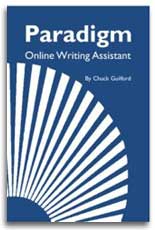Our language organizes thoughts into sentences. As a core, these sentences have a two-part structure. For simplicity and easy reference, we can represent the two parts as follows:
SUBJECT PREDICATE
The subject, a noun or noun-substitute, tells who or what is doing something. The predicate tells what the subject is doing.
| SUBJECT | PREDICATE |
| This bird | sings. |
| Marcus | plays soccer. |
| My old Chevy | still runs. |
| This pen | leaks. |
| These books | are heavy. |
This two part structure is so basic that a thought doesn't feel complete when one part is missing. Both are needed for a complete sentence. Of course most sentences are longer and more sophisticated than those above, but even the most complex sentences are based on this two part principle. Learning to recognize it, to listen for it, and to use it are the first steps to mastering English sentence structure.
The S V/C Pattern
Another step, slightly less important but still useful, is to see that the predicate is often composed of two parts.
SUBJECT PREDICATE
SUBJECT VERB/COMPLEMENT
The verb is the word or cluster of words actually naming the action performed by the subject. The complement comes after the verb. It may do a number of different things, but most often it's the receiver of the action performed by the subject and named by the verb:
SUBJECT VERB/COMPLEMENT
John hit/the ball.
Here John is an agent, the one doing something. "Hit" names the action he's performing, and "the ball" receives the effect of the action. Not all cases are so clear, however. Sometimes the complement modifies the subject, as in "John is tall." Here, "tall" doesn't receive the effect of the action. In fact, there doesn't seem to be any action at all, unless we consider merely existing to be an action. But such cases need not cause problems as long as we recognize the basic pattern and sense that it has been completed. For us, as writers, a detailed understanding of linguistics is secondary. Learning to use the language effectively comes first.
For now, it's enough to say that the basic pattern upon which English sentences are built is:
|
VERB | / COMPLEMENT |
|
V |
/ C |
|
eats |
/ apples. |
|
is |
/ happy. |
|
form |
/ governments. |
|
serves |
/ everyone. |
|
are | / dangerous. |
|
builds | / endurance. |
Each of these is a simple sentence. Because it can stand by itself as a complete sentence, it's also called an independent clause. Because it often serves as the foundation of a much longer sentence, it's sometimes called a base clause. What we call it, though, is less important than learning to sense its presence in every sentence we build.
Activities
4.1 Some word groups listed below contain a subject and predicate and are therefore complete sentences. Others do not and can therefore be considered fragments or parts of sentences. If the word group is a sentence, put an S in the corresponding space. If it is a fragment, put an Fr in the space.
a. __ Beyond the big river.
b. __ Huge waves lapped the prow.
c. __ More than enough money.
d. __ Sitting down together for Sunday breakfast.
e. __ Her wound healed.
f. __ Earlier and earlier each night.
g.__ The sun slipped below the horizon.
h. __ Steeping the neighborhood in shadow
i. __ Calling us in from our play.
j. __ Our mother was cooking supper.
4.2 The following word groups are all simple sentences. Label the subject, the verb, and the complement by writing the appropriate letter above each.
a. Morning dawned gray and heavy.
b. That basket broke the old record.
c. You are not alone.
d. Storm warnings don't scare me.
e. The students attended the concert.
f. The chimpanzee learned sign language.
g. The new proposal deserves serious consideration.




